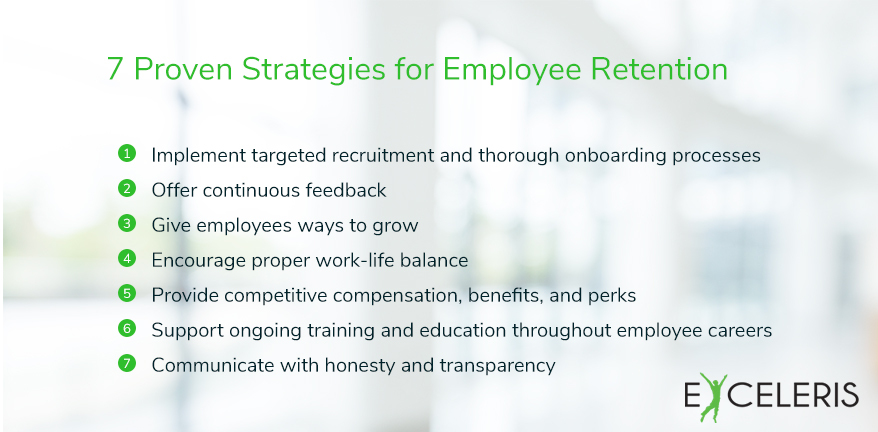A recent report from RBC showed that the number of Canadians who quit their job in June tripled 2020’s levels. Unsatisfied workers are looking for new opportunities as the country reopens and the economy recovers. To maintain business operations and reach your growth goals, you need to know how to retain and engage your talented team. This is where implementing employee retention strategies can help.
What is Employee Retention?
You’ll often see employee retention presented as a metric measuring the proportion of employees who stay with a company over time. The formula is straightforward:
In Canada, the latest employee retention data shows voluntary turnover at 12 percent, involuntary turnover at 7 percent, and retirements of 1 percent, creating a retention rate of 80. The employment report, compiled before 2021, also reveals that 77 percent of those voluntarily leaving jobs decided to pursue a ‘better’ employment situation.
But employee retention is more than a simple statistic. It’s a measure that indicates whether your team is motivated to stay with you and deliver results for the benefit of your organization.
Why is Employee Retention Important?
Retaining your team helps your company in several ways:
1. You’ll save money
Estimates vary, but the cost to replace a talented team member is high.
- Data suggests that the search for a salaried employee costs between 6 and 9 months of their annual wages. A $60,000 role could require up to $45,000 to cover the price of advertising, paying a recruiter, and soft costs associated with reviewing resumes, phone screens, and interviews.
- Depending on the role you’re trying to fill, you may also face additional expenses from paying overtime wages.
2. You’ll strengthen your company’s culture
When you have a stable team, your employees establish bonds based on trust, respect, and knowledge of each other. The resulting positive morale boosts confidence, discipline, and personal performance. You’ll have a group of employees who are engaged in creating a successful team and company.
→ Learn more on employee engagement
3. You’ll improve company performance
A seasoned team of experts puts their skills and knowledge to work, helping the organization achieve its mission. Retaining talented employees also helps with recruitment; after all, everyone wants to be part of a winning team!
Proven Strategies for Employee Retention
By establishing a structure of processes and tactics for every role in your organization, you’ll improve your employee retention rate. Here are some strategies with proven results:
1. Implement targeted recruitment and thorough onboarding processes
Take time to talk with your hiring managers to ensure role descriptions are complete and accurate. Then, select recruiting sites or channels that connect you with qualified candidates. After hiring, set up your new team members for success by teaching them how their role contributes to the culture and overall company performance.
→ See how Exceleris can help with your recruitment and talent acquisition in accounting and finance.
2. Offer continuous feedback
While annual performance reviews have merit as a tool for confirming goal achievement and setting new targets, more frequent communication helps team members pivot successfully to stay on track. Weekly, monthly, or quarterly informal conversations give employees time to ask questions and confirm that their current goals align with the company’s direction.
3. Give employees ways to grow
Tactics for showcasing ways to grow in your organization are:
- Use feedback meetings to identify opportunities and discuss areas for professional growth. Conversations that evaluate team members’ long-term goals combined with skills assessments can help craft plans for career advancement.
- Promote from within and have clear succession paths to create a compelling incentive for employees to stay with your organization.
- Challenge team members to take risks (and accept failure). This encourages employees to believe in themselves
4. Encourage proper work-life balance
If team members believe they are spending more time working than living, they may blame the job for lack of balance. Even those who overwork because of their own philosophy or nature will struggle without vacation. Paid time off or a random paid day helps employees achieve balance. But more significant benefits of work-life balance include:
- Less stress and better physical health, reducing employee illness and fatigue and boosting energy.
- More mental resilience, which improves productivity and creativity at home and work.
- Healthier relationships that will help employees feel connected to people and their work.
5. Provide competitive compensation, benefits, and perks
Salary and benefits are more than a paycheck and healthcare. Both are essential, but employee retention improves with additional rewards such as:
- Stock options or financial rewards or bonuses for exceeding goals. Recent industry research shows that almost 90 percent of companies view bonuses and incentives as vital perks for employee retention over the next 5 years.
- Flexible schedules, paid leave, and a clear work-from-home policy demonstrate a high level of trust and recognition of team member value. Your willingness to partner with employees to help them fulfill work expectations and achieve personal goals also contributes to work-life balance.
6. Support ongoing training and education throughout employee careers
Investing in skills training, business conferences, or educational programs tells employees that you prioritize their development and want them to remain with the team. Upskilling your team gives them new competencies to keep pace with changing business needs.
Life skills training in areas such as financial management, health & wellness, communication, or stress management also lets employees know you’ll support their overall quality of life.
7. Communicate with honesty and transparency
Information empowers employees to make good decisions. When you encourage open communication throughout your organization, you’ll build enthusiasm for your shared goals and foster a sense of cohesiveness across your teams. Consider hosting monthly or quarterly meetings where employees can raise concerns and offer suggestions about business processes.
Conclusion
Implementing employee retention strategies certainly takes time and energy, however, the benefits that come with it far outweigh the drawbacks. The combined result of effective retention strategies not only stabilizes your team but also increases employee engagement and supports business growth.
As a Montreal accounting and finance recruitment agency, Exceleris can assist you in your recruitment process for accounting, taxation, and finance positions. We will recruit for you candidates that perfectly match your needs and your company’s culture, with a long-term vision of growth and succession. Do not hesitate to contact us for more information.





